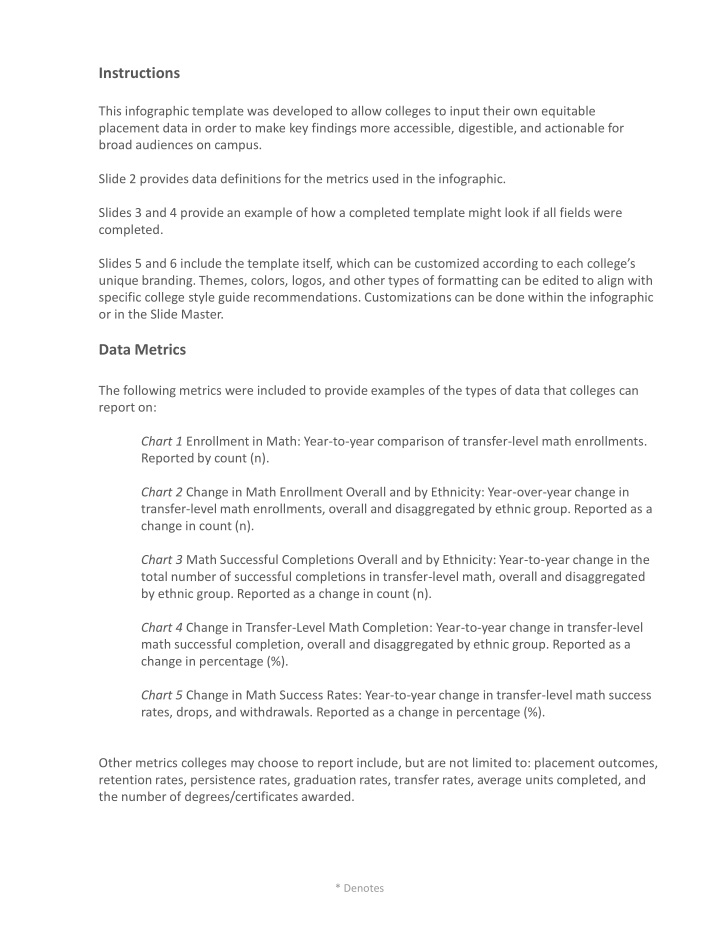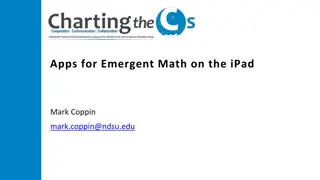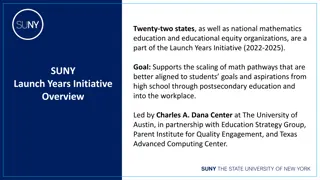
Equitable Placement Outcomes in Transfer-Level Math Statistics
Discover key findings on equitable placement outcomes in transfer-level math statistics at colleges through a customizable infographic template. Learn about enrollment trends, successful completion rates by ethnicity, and other important metrics to drive actionable insights. Customize the template to align with your college's branding and style guide recommendations for comprehensive reporting and analysis.
Download Presentation

Please find below an Image/Link to download the presentation.
The content on the website is provided AS IS for your information and personal use only. It may not be sold, licensed, or shared on other websites without obtaining consent from the author. If you encounter any issues during the download, it is possible that the publisher has removed the file from their server.
You are allowed to download the files provided on this website for personal or commercial use, subject to the condition that they are used lawfully. All files are the property of their respective owners.
The content on the website is provided AS IS for your information and personal use only. It may not be sold, licensed, or shared on other websites without obtaining consent from the author.
E N D
Presentation Transcript
Instructions This infographic template was developed to allow colleges to input their own equitable placement data in order to make key findings more accessible, digestible, and actionable for broad audiences on campus. Slide 2 provides data definitions for the metrics used in the infographic. Slides 3 and 4 provide an example of how a completed template might look if all fields were completed. Slides 5 and 6 include the template itself, which can be customized according to each college s unique branding. Themes, colors, logos, and other types of formatting can be edited to align with specific college style guide recommendations. Customizations can be done within the infographic or in the Slide Master. Data Metrics The following metrics were included to provide examples of the types of data that colleges can report on: Chart 1 Enrollment in Math: Year-to-year comparison of transfer-level math enrollments. Reported by count (n). Chart 2 Change in Math Enrollment Overall and by Ethnicity: Year-over-year change in transfer-level math enrollments, overall and disaggregated by ethnic group. Reported as a change in count (n). Chart 3 MathSuccessful Completions Overall and by Ethnicity: Year-to-year change in the total number of successful completions in transfer-level math, overall and disaggregated by ethnic group. Reported as a change in count (n). Chart 4 Change in Transfer-Level Math Completion: Year-to-year change in transfer-level math successful completion, overall and disaggregated by ethnic group. Reported as a change in percentage (%). Chart 5 Change in Math Success Rates: Year-to-year change in transfer-level math success rates, drops, and withdrawals. Reported as a change in percentage (%). Other metrics colleges may choose to report include, but are not limited to: placement outcomes, retention rates, persistence rates, graduation rates, transfer rates, average units completed, and the number of degrees/certificates awarded. * Denotes
Data Definitions Enrollment: Student enrollment is a duplicated count of students. Students may be enrolled in more than one course and would be counted in each course for the term. Includes all valid enrollments including withdrawals and excused withdrawals. Successful Course Completion Rate (Success Rate): The percentage of students who receive a passing grade of A, B, C, P, CR at the end of the term divided by the total number of students enrolled in the course including non passing and withdrawal grades (including excused withdraws). Transfer-Level Course Completion Rates: The proportion of a cohort of students who complete the transferable or gateway math course within one full academic year of entering their first course in the sequence. For example, if a student first enrolled in a math course in the fall, they would be tracked through the following summer term. Successful Course Completion (Success Count): The number of students who receive a passing grade of A, B, C, P, CR at the end of the term. Drops: The percentage of students who were enrolled in the class on the start of the term and drop with no grade of record by the drop deadline. Withdrawals: The percentage of students who withdraw, including excused withdraws, from the class after the drop period, but before 80% of the course has been completed, excluding excused withdrawals. * Denotes
Equitable Placement Outcomes: Transfer-Level Math (Statistics) As they relate to enrollment, success, withdrawals, drops and transfer-level course completion. 4,522 3,627 Enrollment in Statistics increased by 895 students in Overall Enrollment Gains 2018-19 compared to 2017-18 Enrollment in Statistics increased 25% overall between 2017- 18 and 2018-19 2017-18 2018-19 Enrollment by Ethnicity Statistics Enrollment in Statistics increased for all ethnic groups between 2017-18 and 2018-19 Change in Enrollment Count 2017-18 to 2018-19 Overall Hispanic* +895 +401 White Non-Hispanic +249 +895 +895 Enrollments Asian +184 African-American* +26 +20 +11 +4 Filipino Pacific Islander* American Indian/Alaskan Native* *Denotes DI Group Successful Course Completion by Ethnicity Statistics Successful completions in Statistics increased for all ethnic groups between 2017-18 and 2018-19 Change in Successful Completions 2017-18 to 2018-19 Overall Hispanic* +676 +327 White Non-Hispanic +180 +135 +676 +676 Successful Completions Asian Filipino +14 +12 +7 +1 African-American* Pacific Islander* American Indian/Alaskan Native*
Transfer-Level Course Completion Rates Transfer-level course completion for Statistics increased for all ethnic groups between 2017-18 and 2018-19 Gains in Transfer- Level Course Completion Overall +9% Asian +14% Completion rates in Filipino +13% Statistics increased African-American* +12% Hispanic* 9% overallbetween +11% White Non-Hispanic +9% 2017-18 and 2018-19 Pacific Islander* +4% American Indian/Alaskan Native* +3% Success rates increased for 1out of 4 DI groups* Success Rates, Drops, and Withdrawals Course success rates for Statistics decreased 4% between 2017-18 and 2018-19, while drops increased 2% and withdrawals decreased 1% Success Rates Drops Withdrawals +2% Withdrawals decreased for 2 out of 4 DI groups -1% -4% Background Information MATH10 Enrollment Ethnicity 2017-18 2018-19 In fall 2019, the Math department changed the way they placed students in compliance with equitable placement. All students were eligible to enroll in Statistics with high school transcripts. Students with a HSGPA between 1.9 and 2.6 can enroll in Statistics with an optional corequisite, students with a HSGPA below 1.9 are required to take Statistics with a corequisite. Students without high school transcripts can use guided self-placement into Statistics with or without support. *disproportionately impacted groups Total 3,627 4,522 African-American 217 243 Asian 1,433 1,617 Filipino 290 310 Hispanic 1,067 1,468 American Indian/Native Alaskan 10 14 Pacific Islander 21 32 White Non-Hispanic 589 838






















